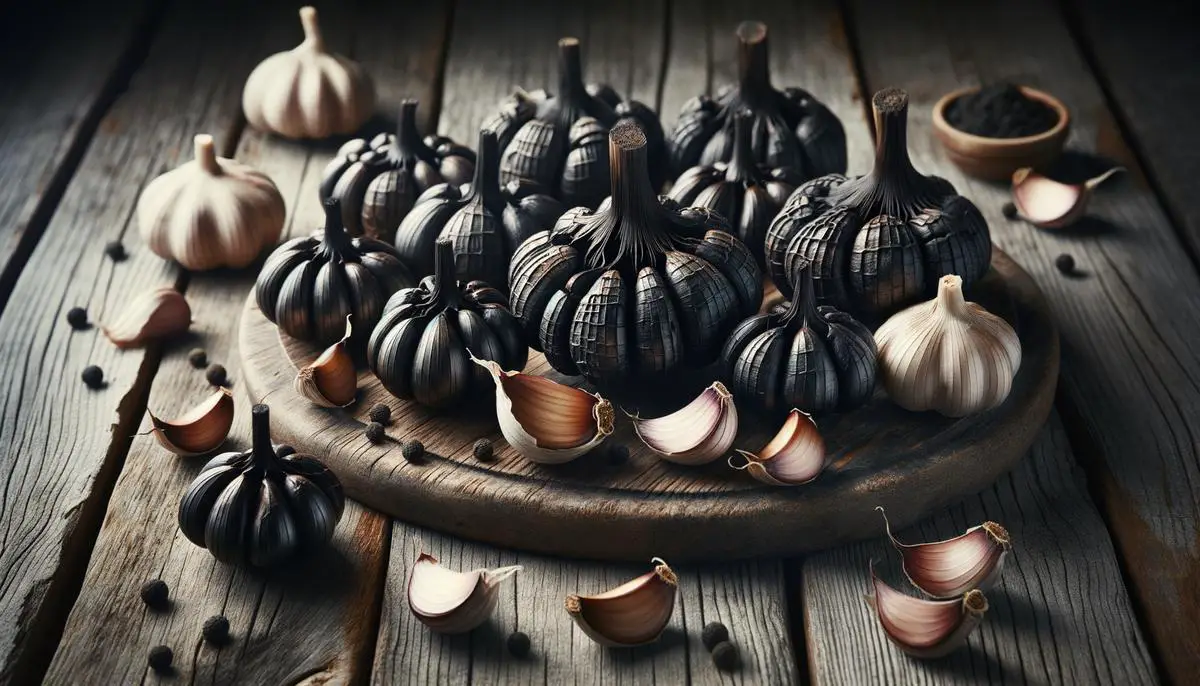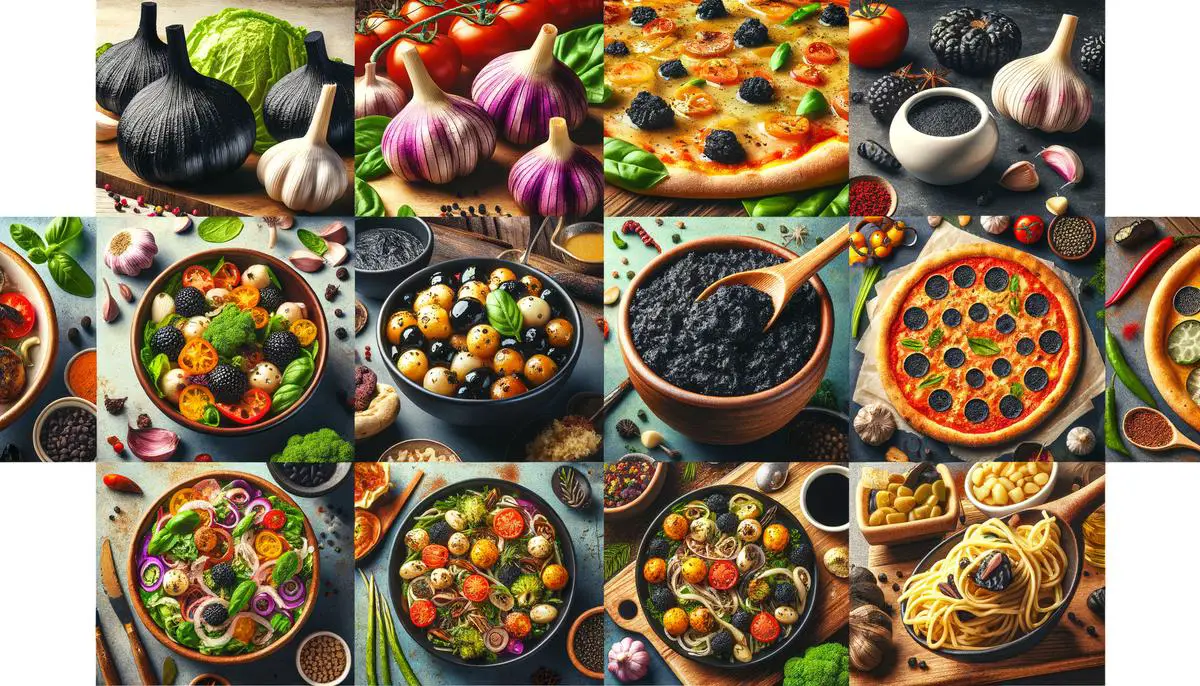
Fermentation and Composition of Black Garlic
Black garlic starts its journey as ordinary white garlic, but it undergoes a magical transformation when subjected to precise conditions. Held at temperatures ranging from 140°F to 190°F (60°C to 87°C) with high humidity for several weeks, raw garlic morphs into what we know as black garlic. This careful process is called fermentation and aging simultaneously.
During this time, garlic undergoes significant chemical changes, the most notable being the Maillard reaction. This non-enzymatic browning process does more than darken the color; it enriches the garlic's natural flavors, striking a balance between sweet and savory that's reminiscent of balsamic vinegar or soy sauce. Allicin, the compound responsible for fresh garlic's strong odor, transforms into antioxidants like alkaloids and flavonoids. These changes significantly enhance the nutritional profile of black garlic.
This aging process boosts the concentration of S-allyl cysteine (SAC), an organic sulfur compound with remarkable anti-inflammatory and antioxidant properties. The increased number of these beneficial compounds helps in scavenging free radicals, thus protecting cells from oxidative stress. It turns every clove into a tiny powerhouse of health-promoting elements.
These alterations also result in other unique compounds. Polysaccharides, S-Allyl-Cysteine, and S-allyl-Mercapto-Cysteine come to the fore. The garlic becomes softer, acquiring a sticky texture akin to dried fruit, making it easy to incorporate into various dishes without the harsh bite of raw garlic.
The precise combination of temperature, humidity, and time ensures that the characteristics and benefits of black garlic are consistent and enhanced. The process boosts its antioxidant capacity two to three times that of raw garlic. Black garlic thus serves as a culinary delight and a functional food with added health benefits.
The unique environment required for fermentation plays a crucial role. The balance between heat and moisture is carefully maintained, making the end product rich in polyphenols and other bioactive compounds. These conditions must be just right, as they determine the levels of antioxidants and the overall quality of black garlic.
From a culinary standpoint, the transformed garlic offers myriad possibilities. With its concentrated health benefits and mellow flavor, black garlic becomes a versatile addition to any kitchen.
Nutritional Benefits
The nutritional benefits of black garlic are extensive, offering everything from enhanced antioxidant capabilities to potential anti-cancer properties. Its antioxidant properties are perhaps the most well-documented. Research indicates that black garlic contains two to three times more antioxidants than its raw counterpart.1 These antioxidants, including phenols, flavonoids, and S-Allyl-Cysteine (SAC), play a critical role in combating oxidative stress, a condition wherein free radicals attack the cells, ultimately leading to inflammation and chronic diseases. By neutralizing these free radicals, black garlic can help stave off conditions like heart disease, cancer, and neurodegenerative disorders.
Black garlic has shown promise in regulating blood sugar levels, a critical factor in managing diabetes and preventing its complications. Studies conducted on animal models have demonstrated that black garlic can help lower blood glucose and insulin levels, and even improve indicators of metabolic health.2 The precise mechanism is thought to involve enhancing the body's antioxidant defense system and improving the function of pancreatic cells. These effects make black garlic a valuable dietary addition for individuals struggling to maintain healthy blood sugar levels.
Brain health is another area where black garlic shines. Thanks to its anti-inflammatory properties, black garlic can potentially reduce brain inflammation, which is linked to cognitive decline and diseases like Alzheimer's. Scientific findings suggest that compounds in black garlic can inhibit the formation of harmful plaques in the brain, thereby preserving memory and cognitive function.3 Its neuroprotective properties are also attributed to its high antioxidant content, which safeguards brain cells from oxidative damage.
Maintaining heart health is another compelling reason to include black garlic in your diet. It has been shown to influence cholesterol levels positively by reducing LDL (bad) cholesterol while increasing HDL (good) cholesterol. This dual action improves the lipid profile and enhances overall cardiovascular health. Additionally, black garlic is known to improve blood circulation and reduce inflammation in the arteries, thereby decreasing the risk of heart disease.4 Studies conducted on both animals and humans have corroborated these heart-healthy benefits.
The anti-inflammatory properties of black garlic are equally impressive. Chronic inflammation is a precursor to many diseases, including arthritis, heart disease, and cancer. Compounds in black garlic like S-Allyl-Cysteine (SAC) and pyruvate have been shown to suppress pro-inflammatory cytokines, thus reducing inflammation at a cellular level.5 This makes black garlic a flavorful addition to meals and a functional food that can help manage or prevent chronic inflammatory conditions.
Black garlic holds potential in fighting cancer as well. Its high levels of antioxidants and anti-inflammatory compounds work together to inhibit the growth of cancer cells. Studies, primarily in test tubes, have shown that black garlic extract can be toxic to cancer cells, including those of the lung, breast, stomach, and liver.6 These anti-cancer properties are thought to be due to the enhanced bioactive compounds generated during the fermentation process, which help reduce oxidative stress and inflammation—two critical factors in cancer development.
In summary, black garlic is more than just a culinary delight; it is a treasure trove of health benefits backed by scientific research. From its powerful antioxidants to its ability to regulate blood sugar, protect the brain, bolster heart health, reduce inflammation, and fight cancer, black garlic proves to be a versatile and functional addition to any diet. Incorporating this superfood into your meals not only enhances flavor but also provides a myriad of health benefits.

Usage and Culinary Applications
Black garlic's versatility in the kitchen is unparalleled. Its unique flavor profile, which balances sweetness with a slight tang, allows it to complement an array of dishes without overpowering other ingredients. Let's explore the myriad ways you can integrate this gourmet gem into your culinary endeavors, enhancing flavor and nutrition.
One of the simplest yet most delightful ways to use black garlic is in salads. Its sweet, umami flavor pairs exceptionally well with a wide range of ingredients. For a fresh, invigorating salad, try the following:
- Dice black garlic and mix it with a balsamic vinaigrette.
- Drizzle this dressing over a bed of mixed greens.
- Add sliced apples, candied walnuts, and crumbled goat cheese for an extraordinary medley of flavors and textures.
Black garlic also shines in stir-fries. Its mellow taste adds depth without overshadowing the primary components. Here's how to incorporate it:
- Start your stir-fry with a base of oils, like sesame or olive oil.
- Add minced black garlic alongside other aromatics such as onions, ginger, and chili flakes.
- Toss in your choice of vegetables, tofu, or meats.
- Finish with a splash of soy sauce and a sprinkle of sesame seeds.
The result is a deeply flavorful dish where every bite reveals a hint of black garlic's complexity.
Dips and spreads are another excellent avenue for black garlic's culinary application. Experiment with mashing black garlic into creamy bases, transforming them into gourmet condiments. A simple black garlic aioli can elevate any sandwich or burger: blend a few cloves of black garlic with mayonnaise, a squeeze of lemon, and a pinch of sea salt. For a more elaborate option, create a black garlic hummus. Puree chickpeas, black garlic, tahini, olive oil, and a hint of cumin until smooth. This hummus provides a nutritional boost and offers a nuanced flavor that's perfect for dipping vegetables or spreading on whole grain crackers.
Pasta dishes benefit greatly from black garlic's subtle sweetness and umami notes. In a simple garlic pasta, sauté minced black garlic in olive oil over low heat to prevent burning. Add cooked pasta to the pan, tossing it to coat. Finish with freshly grated Parmesan cheese, a sprinkle of black pepper, and a few torn basil leaves. The result is a comforting, richly flavored dish that only requires a handful of ingredients.
Elevate your pizzas by thinly slicing black garlic and distributing it evenly over the toppings before baking. Its unique flavor complements traditional toppings like mozzarella, cherry tomatoes, and fresh basil, creating a gourmet pizza experience. Alternatively, mix black garlic with olive oil to create a luxurious garlic oil drizzle for pasta dishes, bruschetta, or even a finishing touch on soups.
Another innovative use of black garlic is blending it into a compound butter. Soften unsalted butter and mix in finely chopped black garlic, along with fresh herbs like parsley or thyme, and a dash of sea salt. Roll it into a log and refrigerate. This black garlic butter can be sliced and used to finish grilled steaks, roasted vegetables, or even spread on crusty bread for a delicious appetizer.
When using black garlic, it's crucial to remember its potent flavor. Starting with lesser quantities is advisable, gradually increasing to taste. Unlike raw garlic, black garlic doesn't need to be cooked extensively—its flavors are already developed, meaning you can add it late in the cooking process or even use it raw in certain applications.
Incorporating black garlic into your culinary repertoire not only enhances dishes but also adds a layer of sophistication. Whether it's through dressings, stir-fries, dips, pastas, pizzas, or compound butters, the practical uses of black garlic are boundless. With these tips, you can maximize its unique flavor, ensuring that it enhances rather than overwhelms your other ingredients. Embrace black garlic in your kitchen and discover how it can transform ordinary dishes into extraordinary gastronomic experiences.

Potential Side Effects and Considerations
While black garlic offers an array of health benefits and an exquisite flavor profile, it is essential to approach its consumption with an awareness of potential side effects and considerations. Although it is a natural, fermented product, certain individuals may need to exercise caution or seek medical advice before incorporating black garlic into their diet.
One of the primary considerations involves individuals on blood-thinning medications. Both raw and black garlic can influence blood coagulation due to their natural blood-thinning properties.7 While this can be beneficial in preventing conditions like heart disease, it poses a risk for those already managing their medication regime to avoid complications such as excessive bleeding or bruising. It's imperative for anyone taking anticoagulants like warfarin or other blood-thinning agents to consult their healthcare provider before significantly increasing their intake of black garlic.
Individuals with allergies to garlic should be cautious. Allergic reactions can range from mild symptoms like skin rashes and gastrointestinal discomfort to severe reactions such as anaphylaxis. Black garlic, although fermented, still retains the fundamental compounds of raw garlic that could trigger these allergic responses. Therefore, if you have a known garlic allergy or if you experience adverse reactions upon consuming raw garlic, it's best to avoid black garlic or introduce it in minimal amounts under professional guidance.
Pregnant women are another group that may need to consider their black garlic consumption carefully. Although research on black garlic's effects during pregnancy is limited, it's commonly recommended for expecting mothers to consult with their healthcare provider before adding any new supplements or significant dietary changes. This ensures the safety of both mother and baby, especially considering the delicate nature of diet during pregnancy.
Aside from these groups, anyone considering black garlic for its medicinal benefits should approach it with a sense of moderation. Overconsumption, particularly on an empty stomach, might lead to mild gastrointestinal issues like bloating or acid reflux. It's always best to start with smaller quantities and gradually increase to gauge individual tolerance.
In summary, while black garlic is a healthful addition to many diets, it is essential to remain mindful of its potential side effects and interactions, especially for individuals on blood thinners, those with garlic allergies, and pregnant women. Consulting a healthcare professional ensures that you can safely enjoy the benefits of black garlic without adverse effects. This approach balances enthusiasm for new culinary adventures with a prudent awareness of personal health considerations.
- Kimura S, Tung YC, Pan MH, Su NW, Lai YJ, Cheng KC. Black garlic: A critical review of its production, bioactivity, and application. J Food Drug Anal. 2017;25(1):62-70.
- Jung YM, Lee SH, Lee DS, et al. Fermented garlic protects diabetic, obese mice when fed a high-fat diet by antioxidant effects. Nutr Res. 2011;31(5):387-396.
- Nillert N, Pannangrong W, Welbat JU, Chaijaroonkhanarak W, Sripanidkulchai K, Sripanidkulchai B. Neuroprotective Effects of Aged Garlic Extract on Cognitive Dysfunction and Neuroinflammation Induced by β-Amyloid in Rats. Nutrients. 2017;9(1):24.
- Ried K, Travica N, Sali A. The Effect of Aged Garlic Extract on Blood Pressure and Other Cardiovascular Risk Factors in Uncontrolled Hypertensives: The AGE at Heart Trial. Integr Blood Press Control. 2016;9:9-21.
- Qu X, Gao H, Tao L, et al. Antimicrobial and anti-inflammatory activities of fermented black garlic. J Food Sci Technol. 2019;56(1):479-488.
- Dong M, Yang G, Liu H, Liu X, Lin S, Sun D, Wang Y. Aged black garlic extract inhibits HT29 colon cancer cell growth via the PI3K/Akt signaling pathway. Biomed Rep. 2014;2(2):250-254.
- Mahdavi-Roshan M, Zahedmehr A, Mohammad-Zadeh A, Sanati HR, Shakerian F, Firouzi A, Bagheri Amiri F. Effect of garlic powder tablet on carotid intima-media thickness in patients with coronary artery disease: a preliminary randomized controlled trial. Nutr Health. 2013;22(2):143-155.



